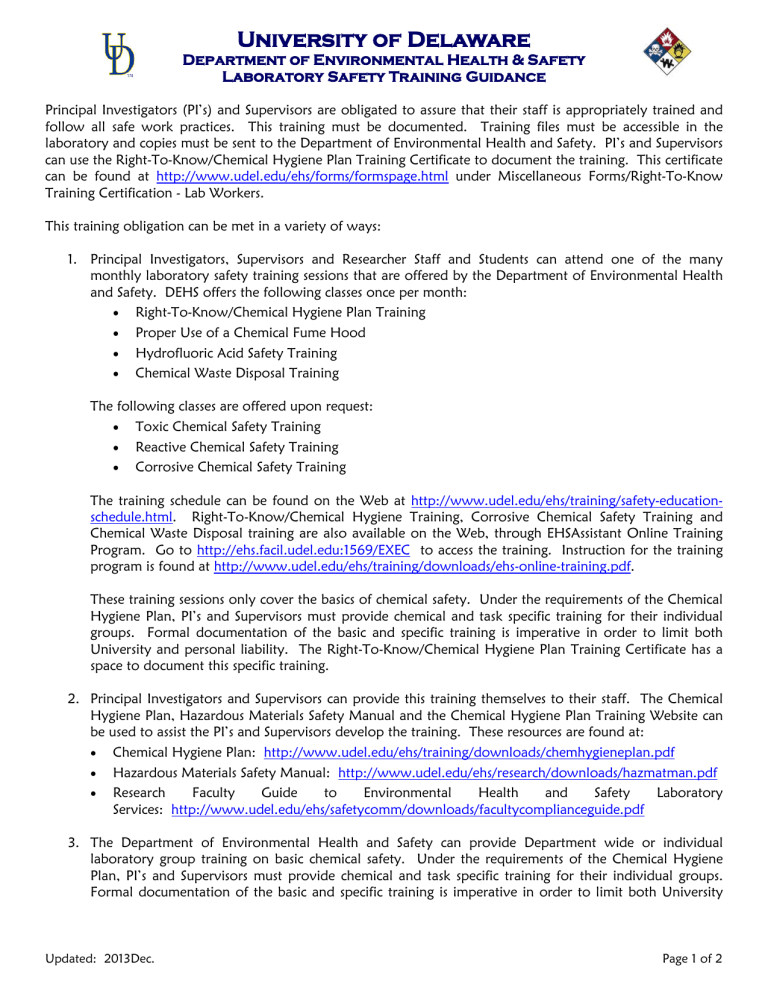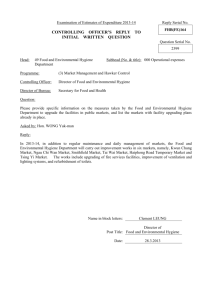University of Delaware Department of Environmental Health & Safety

University of Delaware
Department of Environmental Health & Safety
Laboratory Safety Training Guidance
Principal Investigators (PI’s) and Supervisors are obligated to assure that their staff is appropriately trained and follow all safe work practices. This training must be documented. Training files must be accessible in the laboratory and copies must be sent to the Department of Environmental Health and Safety. PI’s and Supervisors can use the Right-To-Know/Chemical Hygiene Plan Training Certificate to document the training. This certificate can be found at http://www.udel.edu/ehs/forms/formspage.html
under Miscellaneous Forms/Right-To-Know
Training Certification - Lab Workers.
This training obligation can be met in a variety of ways:
1.
Principal Investigators, Supervisors and Researcher Staff and Students can attend one of the many monthly laboratory safety training sessions that are offered by the Department of Environmental Health and Safety. DEHS offers the following classes once per month:
• Right-To-Know/Chemical Hygiene Plan Training
•
•
Proper Use of a Chemical Fume Hood
Hydrofluoric Acid Safety Training
• Chemical Waste Disposal Training
The following classes are offered upon request:
•
•
Toxic Chemical Safety Training
Reactive Chemical Safety Training
• Corrosive Chemical Safety Training
The training schedule can be found on the Web at http://www.udel.edu/ehs/training/safety-educationschedule.html
. Right-To-Know/Chemical Hygiene Training, Corrosive Chemical Safety Training and
Chemical Waste Disposal training are also available on the Web, through EHSAssistant Online Training
Program. Go to http://ehs.facil.udel.edu:1569/EXEC to access the training. Instruction for the training program is found at http://www.udel.edu/ehs/training/downloads/ehs-online-training.pdf
.
These training sessions only cover the basics of chemical safety. Under the requirements of the Chemical
Hygiene Plan, PI’s and Supervisors must provide chemical and task specific training for their individual groups. Formal documentation of the basic and specific training is imperative in order to limit both
University and personal liability. The Right-To-Know/Chemical Hygiene Plan Training Certificate has a space to document this specific training.
2.
Principal Investigators and Supervisors can provide this training themselves to their staff. The Chemical
Hygiene Plan, Hazardous Materials Safety Manual and the Chemical Hygiene Plan Training Website can be used to assist the PI’s and Supervisors develop the training. These resources are found at:
• Chemical Hygiene Plan: http://www.udel.edu/ehs/training/downloads/chemhygieneplan.pdf
• Hazardous Materials Safety Manual: http://www.udel.edu/ehs/research/downloads/hazmatman.pdf
• Research Faculty Guide to Environmental Health and Safety Laboratory
Services: http://www.udel.edu/ehs/safetycomm/downloads/facultycomplianceguide.pdf
3.
The Department of Environmental Health and Safety can provide Department wide or individual laboratory group training on basic chemical safety. Under the requirements of the Chemical Hygiene
Plan, PI’s and Supervisors must provide chemical and task specific training for their individual groups.
Formal documentation of the basic and specific training is imperative in order to limit both University
Updated: 2013Dec. Page 1 of 2
University of Delaware
Department of Environmental Health & Safety
Laboratory Safety Training Guidance
and personal liability. The Right-To-Know/Chemical Hygiene Plan Training Certificate has a space to document this specific training.
Task and Chemical Specific Training
Principal Investigators and Supervisors must provide laboratory specific training. This training should include the following:
• A formal, documented discussion of the material or process
♦ PI’s and Supervisors can use the Right-To-Know/Chemical Hygiene Plan Training Certificate to document the training. This certificate can be found at http://www.udel.edu/ehs/chptraining.html.
•
•
•
•
Review the Safety Data Sheet (SDS)
Review the appropriate section of the Chemical Hygiene Plan and the Hazardous Materials Safety
Manual
• Conduct a dry run of the procedure. Consider inviting Environmental Health and Safety, the
Departmental Chemical Hygiene Officer or the Departmental Safety Committee for their input.
• Consult with the Departmental Chemical Hygiene Officer and Departmental Safety Committee as appropriate.
Laboratory personnel should always involve their Principal Investigator/Supervisor when they change a procedure or if they have any questions.
Examples of materials or processes that may require special training (not an exclusive list):
Chemical Carcinogens
Highly Toxic Materials
• Reproductive Toxins
•
•
Chemical of unknown toxicity
New Chemicals brought into the laboratory
• Chemicals with unknown toxicity or properties
•
•
Compressed gasses
Processes/procedures involving pressure (high or low) and vacuums
• Processes/procedures involving open flames
•
•
•
Heating or boiling liquids
Explosive reactions or materials
Use hazardous equipment such as:
♦ Autoclaves
♦
♦
♦
Centrifuges
Chemical Vapor Deposition Units
Glove Boxes
♦
♦
Large scale Operations
Molecular Beam Epitaxy Units
♦ Ovens, reactors or furnaces
• Unattended operations or experiments that proceed after hours (Before 8:00am and after 5:00 pm).
Updated: 2013Dec. Page 2 of 2






